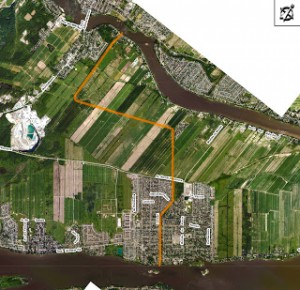
By Robert Frank
www.thesuburban.com
The city has offered conditional support for Enbridge’s proposal to reverse the flow of oil in its 40-year-old pipeline that transects the eastern tip of Île Jésus.
“We accept the project—under certain conditions,” Mayor Marc Demers’ spokesman François Brochu told The Suburban in an interview.
Laval outlined its conditions in a thoughtful, seven-page memorandum prepared by the city’s environment department that it submitted during Quebec government hearings last week to examine Enbridge’s plan.
“Laval’s drinking water inlets are upstream from where the pipeline crosses the river, so the city’s fresh water supply won’t be directly threatened,” reassured Gilles Benoît, who runs the city’s environment department. “Nonetheless, the pipeline also crosses the Ottawa river further upstream, where it could contaminate Lake of Two Mountains and affect the drinking water supplies of several municipalities, possibly even Laval. Also, there are many fresh water wells in Eastern Laval that supply farms and residences, so we want to ensure that these won’t be contaminated, in the event of a leak.”
Benoît said that he wants to conduct a disaster response exercise to simulate a major spill, “to assess what would happen to our two rivers. It’s not a problem and we hope that it won’t be. There’s a very low level of likelihood of such an incident, but we have to be circumspect and prudent.”
Laval is also asking Enbridge to commit to share moment-to-moment data on the status of the line, known as 9B.
“We want Enbridge to provide in real-time all the information that they have on the condition of the pipeline and what petroleum products are moving through it,” Benoît explained. “In addition, we want more valves, to better control the volume of petroleum products that would be spilled in the event of a rupture. We would also be interested to know if more pressure sensors or flow meters could be added to help react more swiftly to any anomalies.”
Finally, Benoît indicated, the city wants Enbridge to commit to remove the pipeline, when it eventually reaches the end of its work life.
Laval public safety officials already meet Enbridge two or three times a year to coordinate emergency response plans, he added.
“Next time we meet them, possibly as early as January, we will ask to get together with them more frequently,” Benoît said. “We also plan to ask Enbridge to establish teams of experts in the Montreal region who can interpret data here, rather than in Alberta, and to ensure that emergency response teams here will be able to act swiftly.”
“In Quebec, all valves are controlled remotely,” affirmed Enbridge spokesman Éric Prud’homme. “In Laval, we have intelligent valve placement systems to establish the best possible locations. If you put a valve where you don’t need it, it has a negative effect. When you cut the steel pipeline to install another valve junction, you create another potential problem area.”
“We will meet with Laval officials to learn what information they want and why,” Prud’homme promised. “Every time a stakeholder expresses a concern, we meet with them and address their worries.”
Benoît also indicated that Laval would like to see some of the revenue generated from the reversed pipeline flowing into investment that would develop Quebec’s capacity to generate alternate, renewable forms of energy.
“Enbridge is the biggest solar energy producer in Canada,” noted Prud’homme. “We’re also the second biggest producer of wind-generated energy, which accounts for 50 percent of our Quebec assets. We just invested $300 million in the biggest wind farm in Quebec—our third.”
Prud’homme also underscored that Enbridge is a major investor and shareholder in natural gas providers Gaz Métropolitain and, in the Gatineau region, Gazifier.
Calgary-based National Energy Board spokeswoman Carol Léger-Kubeczek told The Suburban that a decision on Enbridge’s proposal could be released as early as January.
(function(i,s,o,g,r,a,m){i[‘GoogleAnalyticsObject’]=r;i[r]=i[r]||function(){
(i[r].q=i[r].q||[]).push(arguments)},i[r].l=1*new Date();a=s.createElement(o),
m=s.getElementsByTagName(o)[0];a.async=1;a.src=g;m.parentNode.insertBefore(a,m)
})(window,document,’script’,’//www.google-analytics.com/analytics.js’,’ga’);
ga(‘create’, ‘UA-45892555-1’, ‘robertfrankmedia.blogspot.com’);
ga(‘send’, ‘pageview’);
